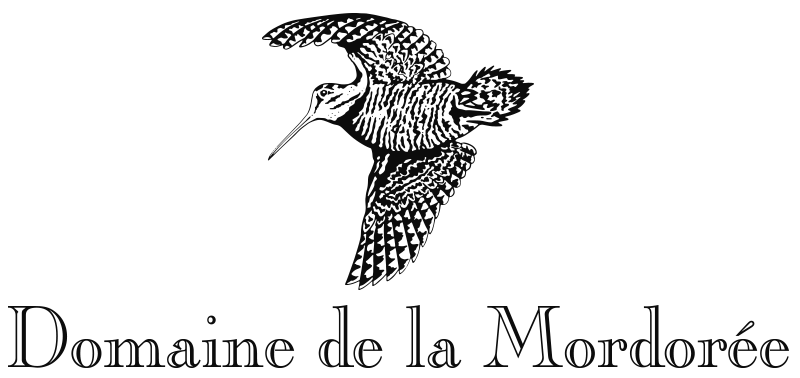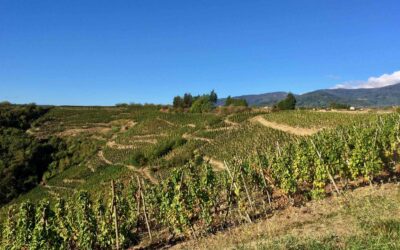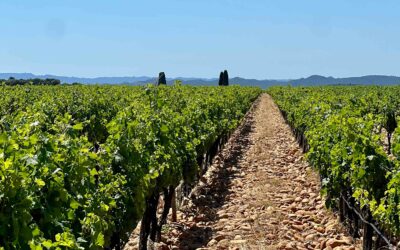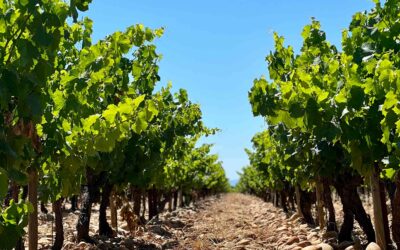Our story
Discover the Domaine de la Mordorée
Domaine de la Mordorée is a family estate, created in 1986 by Francis DELORME and Christophe, the domaine brings together a 57-hectare vineyard divided into 38 plots spread over 8 communes. Is located in the south of France and also in the south of the Rhone Valley.
In 30 years, Christophe Delorme has raised the Domaine de la Mordorée to the level of the greatest. By the «love of the land», this perfectionist, passionate and visionary winemaker has chosen to respect the terroir. The estate is organic in its entirety, with a biodynamic approach in the land and cellar. The harvest is manual on the entire vineyard.
Madeleine and her daughter Ambre have been pursuing the work initiated by Christophe with the team he formed. They chose to preserve the company to which he devoted himself body and soul, in the respect of the main objective: to produce the best possible wines.
Why the domaine de la mordorée ?
Passionate and in love with the wonderful Woodcock, we have chosen a nickname «poetic» to name the estate «La Mordorée», with four other nicknames: «La Remise», «La Dame Rousse», « La Dame Voyageuse «and «La Reine des bois» which symbolize the names of the 4 cuvées. «La Plume du peintre» also for exceptional vintage.



OUR COMMITMENT
Biodiversity
Quality and environment are the keystones of the estate!
The entire vineyard is labelled Biodynamic Agriculture (Demeter) since 2020, the wines are labelled Organic since 2013 and the winery is certified HVE level 3 (High Environmental Value) since 2019.
One of our four major prides is to have recreated sustainable eco-systems in the vineyard, that have miraculously survived to extraordinary events, like those in September 2002 (floods following 600 millimeters of rainfall in two days) or the heat wave of summer 2003.
A search for the natural balance of the different soils allows the vines to have natural defenses against attacks of insects, fungi, bacteria or climatic excesses.
In a few dates
The vineyard has always been in sustainable and reasoned agriculture.
• 2010: Beginning of the organic agriculture conversion
• 2013: Wines are certified organic
• 2019: The entire vineyard changes to HVE level 3 (High Environmental Value)
• 2020: The entire vineyard is labelled Biodynamic Agriculture (Demeter)
The land we grow does not belong to us, we borrow it from our children.
QUOTE FROM ANTOINE DE SAINT EXUPÉRY
Our expertise
Pruning
 At the Domaine, we apply two methods for vine training: the goblet and Royat cordon pruning.
At the Domaine, we apply two methods for vine training: the goblet and Royat cordon pruning.
The goblet is used for all old non-trained vines. This older method is still worthwhile and has the following advantages: better resistance to wind and drought and less sensitivity to wood disease (diseases that can kill the vine).
The Royat cordon pruning method is used for recently wire-trained vines. This new training technique offers many advantages: it makes it easy to train vines in height, therefore increasing the amount of leafing exposed to sunrays, making the grapes richer in colour, tannins and sugar.
Moreover, as the grapes are well exposed to light they develop more aromas and improve the sanitary condition of the berries.
Our pruning is quite strict and selective to guarantee the right number of clusters and better air circulation.
Working the soil
 We only use those natural products that are harmless for the environment, preserving the essential subsoil microbic life: bacteria, insects, and earthworm. The latter are essential for a proper airing and enriching of the earth ; as an example, a normal density of inchworms will “plow” 300 tons of earth per hectare in a single year. To encourage this natural action, we incorporate organic matter in our soils: wood and plant debris, straw etc.
We only use those natural products that are harmless for the environment, preserving the essential subsoil microbic life: bacteria, insects, and earthworm. The latter are essential for a proper airing and enriching of the earth ; as an example, a normal density of inchworms will “plow” 300 tons of earth per hectare in a single year. To encourage this natural action, we incorporate organic matter in our soils: wood and plant debris, straw etc.
It is essential for the soil to be alive and active for the elaboration of complex wines: the roots must reach the depths to feed on the mother plate. As a result, the soils become much less sensitive to erosion, which is one of the greatest plagues of modern times, a plague that threatens the future of agriculture. Not so long ago, a good vineyard was considered one without weeds, and these criteria would distinguish the good wine grower from the bad.
All this was ludicrous and lead wine growers to using increasing amounts of chemical weedkillers, which became more and more powerful and destructive to beat an also increasing weed resistance.
For us, having weeds in our vines is, on the contrary, the evidence our soils are alive. Moreover, these weeds protect the soils from erosion and shelter the
Working on growing vines
 This work must be carried out when the vine is growing.
This work must be carried out when the vine is growing.
It is no doubt in this aspect that we are the most traditional in the good sense of the term: we carry out this whole phase by hand, as wine growers used to do before the all-machine trend. Modern practicality drew many growers away from this wise and reasoned tradition for economic reasons, namely labour costs.
The disbudding phase consists in eliminating all the stems and branches that hamper the bunches of grapes, they favour ventilation and grape maturation while considerably diminishing disease hazard. Moreover, they enhance colour, structure and rich aromas. This is a slow, tedious job that requires considerable time and man labour.
Green harvesting aims at cutting down the number of grape bunches when in excess. The task team can be just as large as the one actually harvesting in fall; these drastic measures control our yield, between 25 and 45 hl/ per hectare, depending on the vintage.
Pollarding, normally carried out to reduce the effect of wind intake from the frightening mistral [S1], is reduced to strict necessity, sometimes even given up altogether for Mourvèdre, to keep the maximum possible leafing. Thinning: leaves hiding clusters are removed, improving ventilation and berry maturation. This reduces the risk of disease and increases berry concentration.
This task is carried out manually over a few weeks.
Mistral: extremely violent wind that comes from the North of the Rhone Valley For more information about Working on growing vines
Special vine care
 After having tested an “organic” approach, and then a biodynamic technique for eight years; we finally shifted for another technique, which truly preserves the environment: durable agriculture.
After having tested an “organic” approach, and then a biodynamic technique for eight years; we finally shifted for another technique, which truly preserves the environment: durable agriculture.
We strongly believe a few things are worth recalling concerning “organic” to agriculture: indeed, a regular use of copper to protect a vineyard generates insoluble problems. Today, it is proven and indisputable that copper is extremely harmful for the environment: it is a heavy metal that nothing can absorb, it concentrates in the soil after each treatment and can wind up making the soil totally sterile.
Later, it goes deep into the subsoil and pollutes groundwater ; as was seen in Germany, some areas totally forbade the use of copper when many wells turned out polluted. As for Switzerland, it has limited authorized amounts to such an extent that it’s nearly impossible to use copper at any time of year !
From now on, we have decided to apply our own methods, based on our experience and are willed to preserve the environment, by introducing to recent concepts that considerably reduce damageable interventions.
Reasoned pest control allows us to treat vines at the opportune moment only. This control calls for careful observation of the vines, literally with a magnifying lens, thus almost halving treatment. This treatment is only carried out with up products that are quickly biodegradable for the action of sun and microorganisms in the soil.
Integrated pest control is a much more complex technique, which aims at using the ecosystem without manmade intervention. The equilibrium is hence naturally found between parasites and predators. Installing natural shelters for auxiliary insects is one of the measures applied in this technique. During our campaigns against the grape-worm, one of the most harmful parasites for the crops, we apply two methods :
• Either we use a bacterium that only destroys this parasite, a natural bacterium, harmless for the environ-ment.
• Or we use sexual confusion which consists in placing odorant capsules that diffuse the pheromones of the female Eudemis butterfly (whose caterpillars are attracted to grapes). These phéromones then saturate the air around the vines, the males are therefore fooled, thinking they will found scores of females, fertilizing the odorant area without ever inseminating the real females: the plague of the grape-worm can almost be eliminated entirely.
The main drawback of this method is its cost, four to five times the cost of a chemical treatment.
The grape harvest
 We are extremely strict concerning grape selection and hand harvesting, we are strongly against the use of harvesting machines for our wines.
We are extremely strict concerning grape selection and hand harvesting, we are strongly against the use of harvesting machines for our wines.
Indeed, harvesting machines are blind when collecting grapes, and therefore naturally cannot select them: grapes, whether half ripe or damaged, will be picked at the same time as good mature grapes.
Machines can more often than not also harvest the small stems (in the upper vine shoots which definitely do not help to the realization of great wines), vine shoots themselves and great quantities of leaves.
As this harvesting method often consists in a violent shaking of the stumps, berries break off the bunches, and all burst into shake: the juices are consequently oxidized and the aromas altered. Conversely, at the Domaine de la Mordorée everything is sorted and controlled. Specific instructions are briefed to all the harvesting crews before their departure to a specific parcel on what is to be picked, left or eliminated. The sorting is then carried out a second time by more specialized workers.
Due to the wealth of grape varieties and lands, harvesting can be carried out at different times, according to the maturity and opportune moment of each vineyard. To monitor this harvesting, we carry out over 100 controls before and during harvest, for the 38 parcels, on 8 different communes.
All these operations, (working the soils, early thinning, special care brought to the vines and harvest) multiply costs by two or three compared to traditional chemical and machine wine growing. We are however certain it would be unacceptable and shameful to waste the prestigious lands and appellations inherited by our forefathers, because of intellectual laziness or greed, and not treat these lands as they deserve.
THE HARVEST IS MANUAL ON THE ENTIRE VINEYARD.
Vinification
 Our philosophy is that nature is much more gifted than man, and that technology is only here to avoid blunders. We therefore let the natural yeasts of our lands do the work, simply checking the evolution of the fermentation through a regular checking and analyzing of the process by an outside oenologist.
Our philosophy is that nature is much more gifted than man, and that technology is only here to avoid blunders. We therefore let the natural yeasts of our lands do the work, simply checking the evolution of the fermentation through a regular checking and analyzing of the process by an outside oenologist.
Recently, in certain cellars, it has become very fashionable to claim that vinification is the essential stage in the creation of wine; backed by somme « Flying Winemakers » and outrageous technology that claim new trendy wines.
(Flying Winemakers or Flying Oenologists, take their name from Latin, OenologusAvestus, and were born from a genetic mutation of terrestrial oenologists, under the joint pressure of the media and great wine amateurs. This mutation most likely takes place when they stay a little too long at the top of a 100 rung ladder)
In the process, it seems one has totally forgotten that the essence is the grape: the grape berry contains all the necessary substances, the pulp, skin, and seeds to make great wines, provided these grapes are perfect. That is why our efforts and investments are first of all concentrated on the vineyard.
Having perfectly healthy and ripe grapes first is the preliminary step for a vineyard to master technology and express the full complexity of wine. Quality grapes are therefore the major assets of great wines.
Of course, vinification is truly important, for it is this stage that will give a wine its character, it is at that moment that man brings his touch, it is what makes a wine unique, like no other. It is another of our strengths at the Domaine de la Mordorée: our wines have a lot of character and are easily recognizable. We try to obtain very concentrated wines with perfectly blended tannins, dense matter, full-bodied and fruity, already delicious young but with a great ageing potential, expressing their breed and origin through time. We are very far from these stylish wines, blinded by technology, all of which look and taste like.
When talking about vinification, everyone has his little secrets… we have ours, so, as Winston Churchill used to say: “Keep your secrets secret !” Weshalladd no more !
OUR TERROIRS
Unique terroirs
To know the history of our terroirs is to listen to them as a caring servant!
Each element contributes to a stratigraphy of successive layers whose vine exploits only the last meters.
A winemaker who has experience knows how to recognize the best soils, he knows how much he is indebted to the land for what he receives through the fruit of the vine and the wine. Good terroirs exist and are revealed by the patience and the requirement of the winemaker, who knows how to listen to them.
To let the terroir reveal itself is, among other things, not to knock it out with weed killers, chemical fertilizers or pesticides. It’s just being humble. To know the history of our terroirs is to listen to them as a caring servant.
Located in Tavel, the terroirs of the Domaine de la Mordorée are the legacy of millions of years of tectonic movements, climate change, glacier flux and ebb, overflowing by the sea, lakes or huge rivers.










